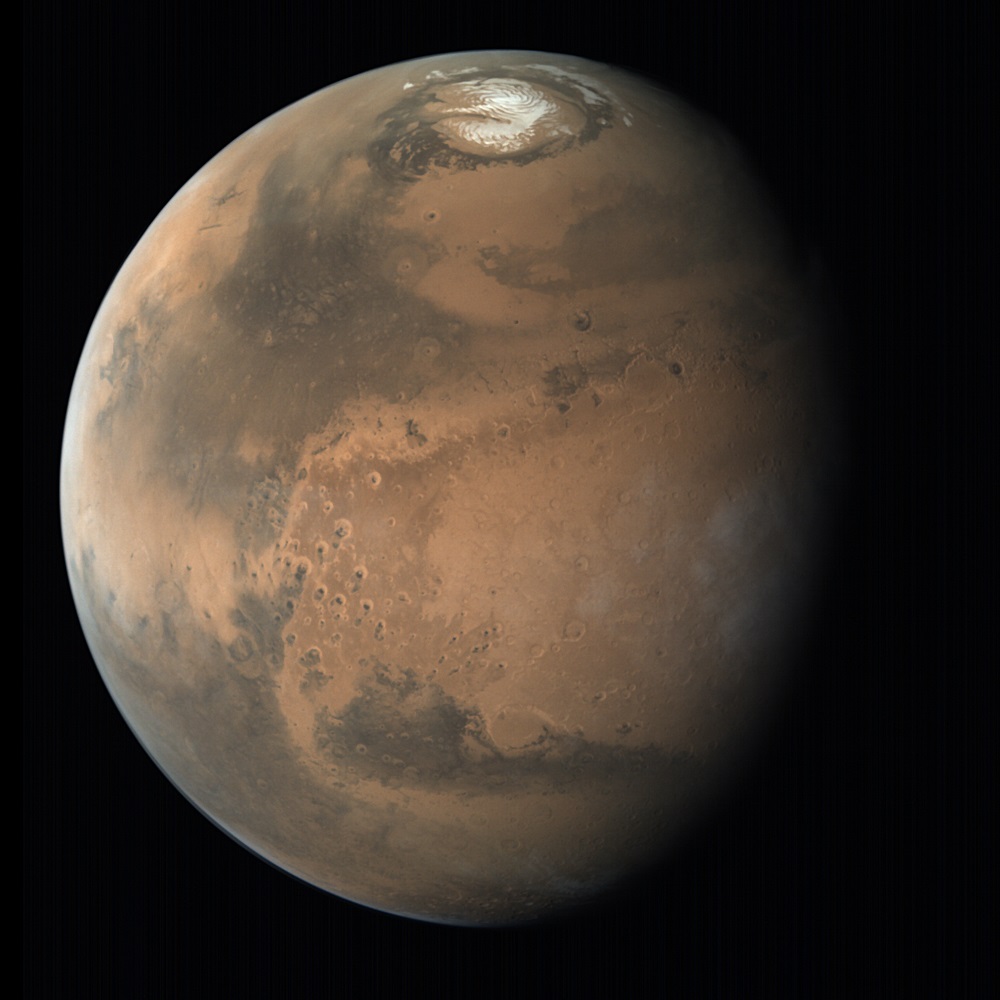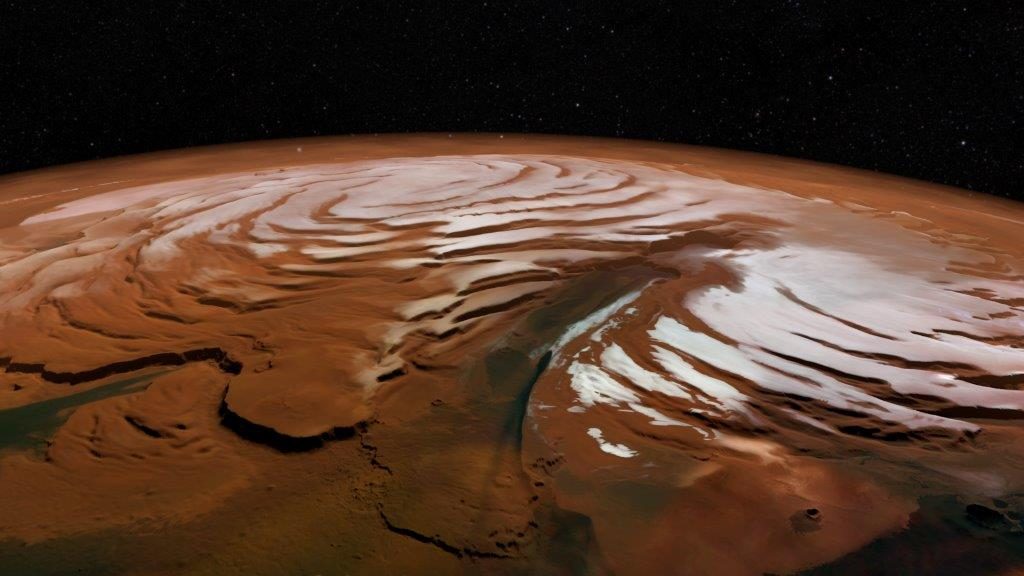22 May 2019

A view of Mars showing the planet’s northern polar ice cap. A new study led by The University of Texas at Austin has found remnants of ancient ice caps buried in the north polar region.
Credit ISRO / ISSDC / Emily Lakdawalla.
AGU press contact:
Lauren Lipuma, +1 (202) 777-7396 (GMT-4), [email protected]
Contact information for the researchers:
Stefano Nerozzi, University of Texas at Austin, +1 (512) 471-6156 (GMT-5), [email protected]
Jack Holt, University of Arizona, +1 (520) 626-7469 (GMT-7), [email protected]
WASHINGTON—Scientists have discovered remnants of ancient ice sheets buried in sand a mile beneath Mars’s north pole, they report in a new study. The findings show conclusive evidence of the waxing and waning of polar ice on the red planet due to changes in its orbit and tilt, according to the study’s authors.
Researchers at the University of Texas at Austin and the University of Arizona made the discovery using measurements gathered by the Shallow Radar (SHARAD) instrument on NASA’s Mars Reconnaissance Orbiter. SHARAD emits radar waves that can penetrate up to a mile and a half beneath Mars’s surface.
The new findings, published today in AGU’s journal Geophysical Research Letters, are important because the layers of ice are a record of past climate on Mars in much the same way that tree rings are a record of past climate on Earth, according to the researchers. Studying the geometry and composition of these layers could tell scientists whether climate conditions were previously favorable for life.
The team found layers of sand and ice that were as much as 90 percent water in some places. If melted, the newly discovered ice would be equivalent to a global layer of water around Mars at least 1.5 meters (5 feet) deep, which could be one of the largest water reservoirs on the planet, according to the researchers.

A vertically exaggerated view of Mars’ north polar cap. Researchers estimate that if melted, the massive ice deposits discovered in this region would cover the planet in 1.5 meters (5 feet) of water.
Credit: SA/DLR/FU Berlin; NASA MGS MOLA Science Team.
“We didn’t expect to find this much water ice here,” said Stefano Nerozzi, a graduate research assistant at the University of Texas Institute for Geophysics (UTIG) and lead author of the new study. “That likely makes it the third largest water reservoir on Mars after the polar ice caps.”
The findings were corroborated by an independent study using gravity data instead of radar, led by researchers at Johns Hopkins University and also published today in Geophysical Research Letters, of which Nerozzi is a co-author.
Layers of sand and ice
The authors suspect the layers formed when ice accumulated at the poles during past ice ages on Mars. Each time the planet warmed, a remnant of the ice caps became covered by sand, which protected the ice from solar radiation and prevented it from dissipating into the atmosphere.
Scientists have long known about glacial events on Mars, which are driven by variations in the planet’s orbit and tilt. Over periods of about 50,000 years, Mars leans toward the sun before gradually returning to an upright position, like a wobbling spinning top. When the planet spins upright, the equator faces the sun, allowing the polar ice caps to grow. As the planet tilts, the ice caps retreat, perhaps vanishing entirely.
Until now, scientists thought the ancient ice caps were lost. The new findings show that in fact significant ice sheet remnants have survived under the planet’s surface, trapped in alternating bands of ice and sand, like layers on a cake.

A composite image showing alternating layers of ice and sand in an area where they are exposed on the surface of Mars. The photograph, taken with the HiRISE camera aboard NASA’s Mars Reconnaissance Orbiter, was adjusted to show water ice as light-colored layers and sand as darker layers of blue. The tiny bright white flecks are thin patches of frost.
Credit: NASA/JPL/University of Arizona.
Jack Holt, a professor at the Lunar and Planetary Laboratory of the University of Arizona and co-author of the new study, said the research provides new, important insights into the exchange of water ice between the poles and the midlatitudes, where his research group previously confirmed the presence of widespread glaciers, also using the SHARAD instrument.
“Surprisingly, the total volume of water locked up in these buried polar deposits is roughly the same as all the water ice known to exist in glaciers and buried ice layers at lower latitudes on Mars, and they are approximately the same age,” he said.
Sudying this record of past polar glaciation could help determine whether Mars was ever habitable, according to Nerozzi.
“Understanding how much water was available globally versus what’s trapped in the poles is important if you’re going to have liquid water on Mars,” Nerozzi said. “You can have all the right conditions for life, but if most of the water is locked up at the poles, then it becomes difficult to have sufficient amounts of liquid water near the equator.”
###
Founded in 1919, AGU is a not-for-profit scientific society dedicated to advancing Earth and space science for the benefit of humanity. We support 60,000 members, who reside in 135 countries, as well as our broader community, through high-quality scholarly publications, dynamic meetings, our dedication to science policy and science communications, and our commitment to building a diverse and inclusive workforce, as well as many other innovative programs. AGU is home to the award-winning news publication Eos, the Thriving Earth Exchange, where scientists and community leaders work together to tackle local issues, and a headquarters building that represents Washington, D.C.’s first net zero energy commercial renovation. We are celebrating our Centennial in 2019. #AGU100
Notes for Journalists
This paper is freely available through June 30. Journalists and public information officers (PIOs) can download a PDF copy of the article by clicking on this link:
https://agupubs.onlinelibrary.wiley.com/doi/pdf/10.1029/2019GL082114
Journalists and PIOs may also request a copy of the final paper by emailing Lauren Lipuma at [email protected]. Please provide your name, the name of your publication, and your phone number.
Neither this paper nor this press release is under embargo.
Paper Title
“Buried ice and sand caps at the north pole of Mars: Revealing a record of climate change in the cavi unit with SHARAD”
Authors
Stefano Nerozzi: Institute for Geophysics, Jackson School of Geosciences, The University of Texas at Austin, Austin, Texas, United States;
Jack W. Holt: Lunar and Planetary Laboratory, Department of Planetary Sciences, University of Arizona, Tucson, Arizona, United States.